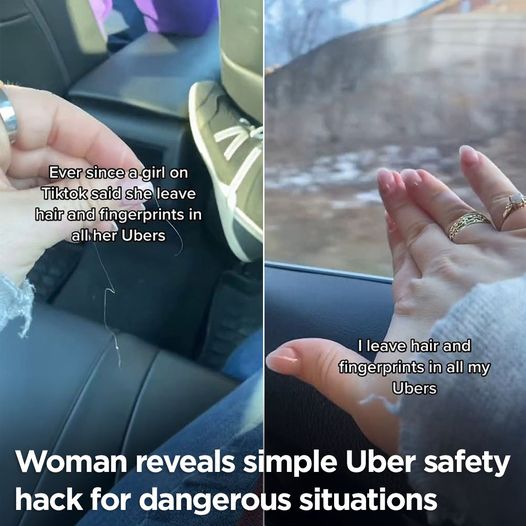“Never accept rides from strangers” used to be a common safety hack. But with rideshare apps, riding with strangers has become normal nowadays. That doesn’t mean it’s entirely safe. In July 2022, Uber made headlines for being the subject of 550 sexual assault and attack allegations. Misconduct, assault, rape, and even murder have occurred through these apps, and it’s hard not to think about these scenarios when you’re sitting alone at night in a stranger’s car. That was the inspiration behind Brennalina’s TikTok video, where she gives a tip for other women nervous about taking Ubers and Lyfts.
The DNA Safety Hack for Rideshares
“Ever since a girl on TikTok said she leaves hair and fingerprints in all her Ubers, I leave hair and fingerprints in all my Ubers,” Brennalina said in a TikTok video. She demonstrates how she leaves strands of hair on the floor and makes fingerprints on the window, leaving clear DNA for a worst case scenario. [1]
Brennalina’s caption reads as “Ladies amirite” and many women seemed to relate. The post has garnered over 3.8 million likes and over 12.9 thousand comments.
“It’s actually sad that I thought this is a good idea. It shouldn’t be like this,” said one commenter. Similarly, another woman wrote: “When it’s like a professional Uber with a divider and iPad I know I’m good bc he won’t risk his full time job for me.”
Other people provided additional tips for the safety hack. “Remember for DNA the hair needs to include the follicle,” one wrote. Another read as, “Make sure you leave fingerprints in places that people forget to clean!! Underneath seats, under handles, back of headrests etc.”
Fortunately, Uber has released a statement following the surplus of allegations, saying it takes “every single report seriously.”
“There is nothing more important than safety, which is why Uber has built new safety features, established survivor-centric policies, and been more transparent about serious incidents,” the statement said. “While we can’t comment on pending litigation, we will continue to keep safety at the heart of our work.” [2]
12 Safety Tips for Rideshare Passengers
The main issue with the hair and fingerprint safety hack is that it prepares for a worst case scenario. But it doesn’t prevent one. Fortunately, there are many ways to avoid danger and make rideshares more safe and less stressful.
-
- Tell someone where you’re going and check in when you arrive at your destination. If you make this a habit, your contact will know if something went wrong. Many rideshare apps have a feature where you share your trip progress with another person, so make the most of it.
-
- Wait for your ride inside. Waiting alone by the curb, clearly waiting for a ride, can make you an easy target for predators pretending to be drivers.
- Check the lisence plate before you get into the car. Rideshare apps provide information like the plate, color, and model of the car to help you find your driver, but it can also confirm that you’re getting into the right vehicle.
- Take a look at the driver before getting inside. Ask for their name and make sure it matches with the driver profile on the app. While you’re at it, be on the lookout for the smell of alcohol or substances, blurred speech, bloodshot eyes, and other symptoms of being under the influence.
- Ask the driver who they’re picking up and don’t offer your name. The app should tell them your name, so if they don’t know it, it’s a major red flag. [3]
- Sit in the back seat instead of beside the driver.
- Once you enter the car, try opening the door again to ensure the driver doesn’t have the child locked on.
- If you chat with the driver, don’t provide any personal information, like about your home, work, social plans, or other details that someone could use to find you later.
- Refuse any drinks or water bottles.
- Monitor the ride to ensure the driver is going in the right direction. If you’ve never been to the location before, track your progress on your own GPS map.
- Trust your instincts. If something feels off, it’s better to be safe than sorry. So don’t be afraid to decline a ride, ask the driver to pull over and let you out, or call 911 or use the emergency feature on the app.
- Report any misconduct to the company, and the police when needed. This could include inappropriate remarks, poor driving skills, or pushes for personal information. [4]
